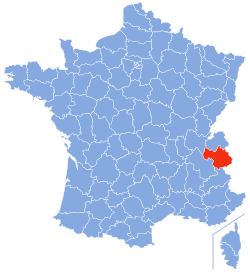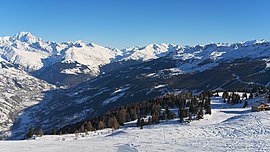Savoie
Savoie
Savouè(Arpitan) | |
|---|---|
From top down:Tresserveon theLac du Bourget,La Plagne,prefecturebuilding inChambéry,Les Arcsski station,Vanoise National Park,Moûtiers CathedralandTignes | |
|
| |
 Location of Savoie in France | |
| Coordinates:45°35′N6°20′E/ 45.583°N 6.333°E | |
| Country | France |
| Region | Auvergne-Rhône-Alpes |
| Prefecture | Chambéry |
| Subprefectures | Albertville Saint-Jean-de-Maurienne |
| Government | |
| •President of the Departmental Council | Hervé Gaymard[1](LR) |
| Area | |
| • Total | 6,028 km2(2,327 sq mi) |
| Elevation | 1,595 m (5,233 ft) |
| Highest elevation | 3,855 m (12,648 ft) |
| Lowest elevation | 208 m (682 ft) |
| Population (2021)[2] | |
| • Total | 442,468 |
| • Rank | 57th |
| • Density | 73/km2(190/sq mi) |
| Time zone | UTC+1(CET) |
| • Summer (DST) | UTC+2(CEST) |
| Department number | 73 |
| Arrondissements | 3 |
| Cantons | 19 |
| Communes | 273 |
| ^1French Land Register data, which exclude estuaries and lakes, ponds and glaciers larger than 1 km2 | |
Savoie(pronounced[savwa];Arpitan:SavouèorSavouè-d'Avâl;English:Savoy/səˈvɔɪ/) is adepartmentin theAuvergne-Rhône-Alpesregion,SoutheasternFrance.Located in theFrench Alps,itsprefectureisChambéry.In 2019, Savoie had a population of 436,434.[3]
Together withHaute-Savoie,it is one of the two departments of the historical region ofSavoy;theDuchy of Savoywas annexed by France in 1860, following the signature of theTreaty of Turin.The area is known for its numerous ski resorts and contribution toFrench cuisine,with culinary specialities such asfondue savoyarde,tartiflette,génépi,as well as various sorts ofsaucisson.
History[edit]
It is widely accepted[citation needed]that Savoie takes its name from theLatinSapaudiaorSabaudia,meaning land covered infirtrees. Savoie was long part of the states ofSavoy;though beginning in the 16th century, it was occupied byFranceseveral times. It was integrated into theMont-Blancdepartmentfrom 1792 to 1815 (and partially into theLémandepartment from 1798 to 1814). The province wasannexedby France in 1860. The formerDuchy of Savoybecame the two departments of Savoie andHaute-Savoie.
Moûtiers,capital of the formerprovince of Tarentaise Valley(French:Vallée de la Tarentaise), ceased to be asubprefecturefollowing a law that took effect on 10 September 1926.
Savoie hosted the1992 Winter Olympics,based inAlbertvillewith ski events atTarentaiseandBeaufortain.The coat of arms for Savoie was used as a pattern for the flames in the official emblem of the games.[4]
The other main alpine valley is theMaurienne,connected to the Tarentaise valley by two passes, thecol de la Madeleineand the highest pass in Europe, thecol de l'Iseran.The Maurienne valley was through thecol du Mont Cenis,the major commercial route between France and Italy. It is one of the longest intra-alpine valleys in the Alps.
Geography[edit]
Savoie is part of theAuvergne-Rhône-Alpesregionestablished on 1 January 2016. It was previously part ofRhône-Alpes.It borders the departments ofHaute-Savoie,Ain,I sắc reandHautes-Alpesin addition to theAosta Valleyand theMetropolitan City of TurininItaly.
Much of Savoie is covered by mountains:
- Mont Blanc Massif
- BelledonneMassif
- Lauzière massif
- Aiguilles d'ArvesMassif
- Massif des Cerces
- Aravis Range
- Mont CenisMassif
- BaugesMassif
- ChartreuseMassif
- Vanoise Massif
- BeaufortainMassif
The department is crossed by theI sắc re river,which has its source in the Iseran pass. Its two main lakes areLac du Bourget(the largest and deepest lake entirely in France) andLac d'Aiguebelette,one of the least polluted in France due to a 1976 law forbidding any use ofmotorboatson the lake.
-
Low elevation: the Savoie frontcountry
-
Mid elevation: Mariet plateau in theBauges Massif
-
High elevation: the village ofAime
Climate[edit]
Most of the department features analpine climateor asubalpine climate.At lower altitudes and in the valleys, the climate ishumid continental(Köppen:Dfb) or evenoceanicin the frontcounrty andlake Bourgetarea (Köppen:Cfb), using the 0 °C (32 °F) isotherm.
Economy[edit]
According to the Chambéry chamber of commerce, close to 50% of the department's wealth comes from tourism. Each year, Savoie hosts over 30 million visitor-nights of tourists. Savoie also profits from its natural resources with particular strengths in ore processing andhydroelectric power.
Savoie had an exceptionally high export/import ratio of 214% in 2005. Its exports rose to €1.768 billion and €825 million in imports. Its leading exports weresteel,aluminum,and electric and electronic components.
Agriculture[edit]
Savoie is famous for its cows, which produce numerouscheeses,some of them are:
Numerous wine grapes are also grown in Savoie. The most famous wines are made ofGamay,Pinot noirandMondeusegrapes. Fruit production is the third largest component of agriculture in Savoie.
Apples and pears are also produced in the region and are well known for their qualities.
Demographics[edit]
|
| ||||||||||||||||||||||||||||||||||||||||||||||||||||||||||||||||||
| |||||||||||||||||||||||||||||||||||||||||||||||||||||||||||||||||||
| source:[5][6] | |||||||||||||||||||||||||||||||||||||||||||||||||||||||||||||||||||
Residents of Savoie are known asSavoyards,though they can also be calledSavoisiens(the historical name) orSavoyens.
Principal towns[edit]
The most populous commune isChambéry,the prefecture. As of 2019, there are 8 communes with more than 7,000 inhabitants:[3]
| Commune | Population (2019) |
|---|---|
| Chambéry† | 58,917 |
| Aix-les-Bains† | 30,463 |
| Albertville | 19,502 |
| La Motte-Servolex† | 12,120 |
| La Ravoire† | 8,530 |
| Saint-Jean-de-Maurienne | 7,621 |
| Bourg-Saint-Maurice | 7,195 |
| Ugine | 7,096 |
| † part of Chambéryagglomeration | |
The "average" (seearithmetic mean) population density is not a good indicator: the valleys tend to be much more densely populated, whereas the mountains tend to be near-completely uninhabited.
Religion[edit]
TheCatholic Churchin Savoie is divided into threedioceses:Chambéry, Maurienne, and Tarentaise. Together, they form anarchdiocese,in which thebishop of Chambéryis thearchbishop.
Politics[edit]
Departmental Council of Savoie[edit]
TheDepartmental Councilof Savoie has 38 seats. 30 councillors are part of the J'aime la Savoie ( "I love Savoie" ) right-wing group; 8 councillors are part of the Savoie pour Tous ( "Savoie for All" ) left-wing group.Hervé Gaymard(The Republicans) has beenPresident of the Departmental Councilsince 2008.Thierry Repentin(Socialist Party) has been Opposition Leader since 1998.
Members of the National Assembly[edit]
Savoie elected the followingmembersof theNational Assemblyduring the2017 legislative election:
Senators[edit]
Savoie is represented by twoSenatorsinParliament.Jean-Pierre VialandMartine Berthethave served since 1995 and 2017 respectively. Both are members ofThe Republicans(LR).
Tourism[edit]
Tourism, which is quite important to Savoie, began to develop towards the end of the 19th century, mostly summer oriented.[citation needed]The increase in the popularity ofskiingin the 20th century made Savoie home to the largest number of ski hills in France, including many famous ones:
- Val-d'I sắc re
- Tignes
- Les Arcs
- La Plagne
- Courchevel
- Méribel
- Valmorel
- Les Menuires
- Val Thorens
- Les Saisies
- Savoie Grand Revard
- Bramans
- Bessans
- Valloire
Hydrotherapy,practised in the region sinceantiquity,is also quite developed. There are four locations that are still active:
-
Casino ofAix-les-Bains
-
Bonneval-sur-Arcin theMauriennevalley
-
Refugeof theAiguilles d'Arves
-
Trains in Savoie
See also[edit]
History[edit]
- Savoy,historical region
- House of Savoy,ruling dynasty of Savoy from 1032 to 1860
- Duchy of Savoy,rulers of Savoy region from 1416 to 1720
- Kingdom of Sardinia,1720 to 1860
Language[edit]
Places[edit]
- Communes of the Savoie department
- Arrondissements of the Savoie department
- Cantons of the Savoie department
- Chambéry
- Aix-les-Bains
- Lac du Bourget,the largest lake in France
Wine[edit]
- French wine,AOC wine of Savoie
- Savoy wineor wine of Savoie Allobrogie
References[edit]
- ^"Répertoire national des élus: les conseillers départementaux".data.gouv.fr, Plateforme ouverte des données publiques françaises(in French). 4 May 2022.
- ^"Téléchargement du fichier d'ensemble des populations légales en 2021"(in French).The National Institute of Statistics and Economic Studies.28 December 2023.
- ^abPopulations légales 2019: 73 Savoie,INSEE
- ^"Albertville 1992 Winter Olympics - Emblem".Olympic Games.International Olympic Committee. 3 October 2018. Archived fromthe originalon 4 December 2018.Retrieved11 December2018.
- ^"Historique de la Savoie".Le SPLAF.
- ^"Évolution et structure de la population en 2016".INSEE.
- ^Nationale, Assemblée."Assemblée nationale ~ Les députés, le vote de la loi, le Parlement français".Assemblée nationale.



















